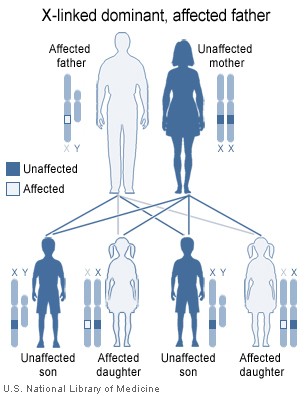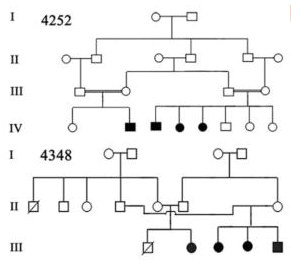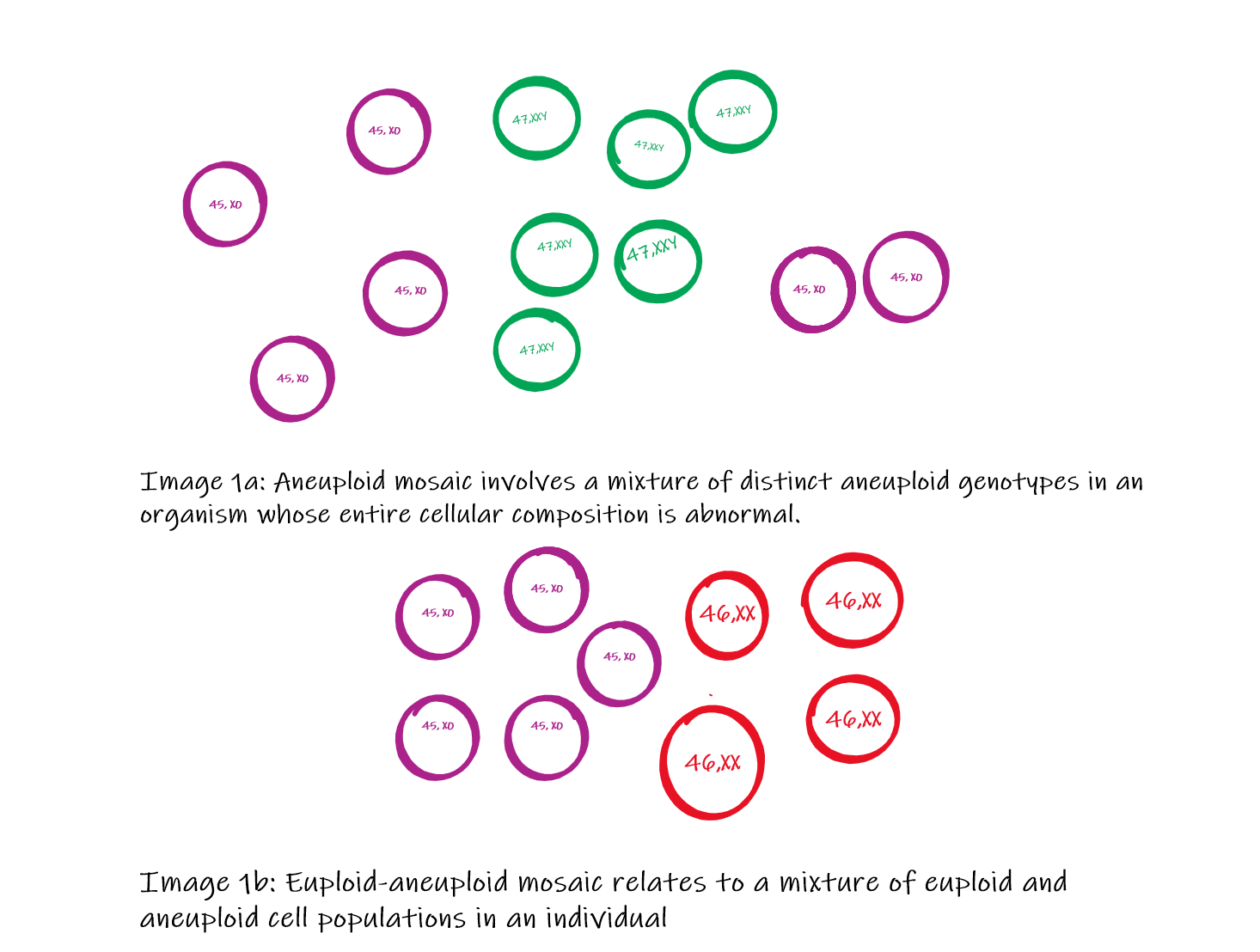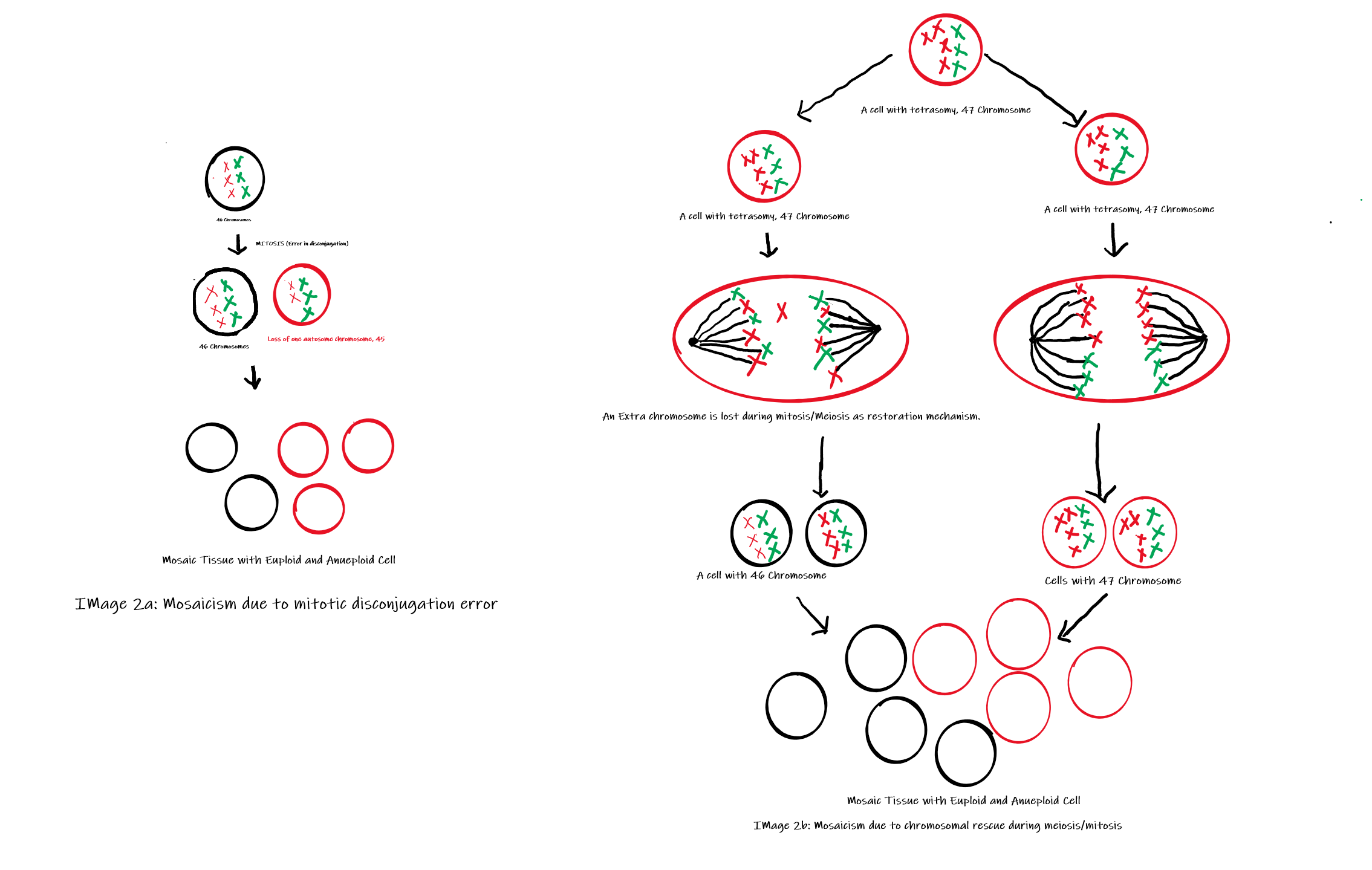[1]
Foulkes WD, Real FX. Many mosaic mutations. Current oncology (Toronto, Ont.). 2013 Apr:20(2):85-7. doi: 10.3747/co.20.1449. Epub
[PubMed PMID: 23559869]
[2]
Moog U, Felbor U, Has C, Zirn B. Disorders Caused by Genetic Mosaicism. Deutsches Arzteblatt international. 2020 Feb 21:116(8):119-125. doi: 10.3238/arztebl.2020.0119. Epub
[PubMed PMID: 32181732]
[3]
Machiela MJ. Mosaicism, aging and cancer. Current opinion in oncology. 2019 Mar:31(2):108-113. doi: 10.1097/CCO.0000000000000500. Epub
[PubMed PMID: 30585859]
Level 3 (low-level) evidence
[4]
Banka S,Metcalfe K,Clayton-Smith J, Trisomy 18 mosaicism: report of two cases. World journal of pediatrics : WJP. 2013 May;
[PubMed PMID: 22105572]
Level 3 (low-level) evidence
[5]
Cohen AS, Wilson SL, Trinh J, Ye XC. Detecting somatic mosaicism: considerations and clinical implications. Clinical genetics. 2015 Jun:87(6):554-62. doi: 10.1111/cge.12502. Epub 2014 Oct 7
[PubMed PMID: 25223253]
[6]
Campbell IM, Shaw CA, Stankiewicz P, Lupski JR. Somatic mosaicism: implications for disease and transmission genetics. Trends in genetics : TIG. 2015 Jul:31(7):382-92. doi: 10.1016/j.tig.2015.03.013. Epub 2015 Apr 21
[PubMed PMID: 25910407]
[7]
Popovic M, Dhaenens L, Boel A, Menten B, Heindryckx B. Chromosomal mosaicism in human blastocysts: the ultimate diagnostic dilemma. Human reproduction update. 2020 Apr 15:26(3):313-334. doi: 10.1093/humupd/dmz050. Epub
[PubMed PMID: 32141501]
[8]
Holstege H, Pfeiffer W, Sie D, Hulsman M, Nicholas TJ, Lee CC, Ross T, Lin J, Miller MA, Ylstra B, Meijers-Heijboer H, Brugman MH, Staal FJ, Holstege G, Reinders MJ, Harkins TT, Levy S, Sistermans EA. Somatic mutations found in the healthy blood compartment of a 115-yr-old woman demonstrate oligoclonal hematopoiesis. Genome research. 2014 May:24(5):733-42. doi: 10.1101/gr.162131.113. Epub 2014 Apr 23
[PubMed PMID: 24760347]
[9]
Gajecka M. Unrevealed mosaicism in the next-generation sequencing era. Molecular genetics and genomics : MGG. 2016 Apr:291(2):513-30. doi: 10.1007/s00438-015-1130-7. Epub 2015 Oct 19
[PubMed PMID: 26481646]
[10]
Chen T, Tian L, Wang X, Fan D, Ma G, Tang R, Xuan X. Possible misdiagnosis of 46,XX testicular disorders of sex development in infertile males. International journal of medical sciences. 2020:17(9):1136-1141. doi: 10.7150/ijms.46058. Epub 2020 May 11
[PubMed PMID: 32547308]
[13]
Verma RS, Kleyman SM, Conte RA. Chromosomal mosaicisms during prenatal diagnosis. Gynecologic and obstetric investigation. 1998:45(1):12-5
[PubMed PMID: 9473156]
[14]
Lee HY,Koo DW,Lee JS, Lichen striatus colocalized with Becker's nevus: a case with two types of simultaneous cutaneous mosaicism? International journal of dermatology. 2020 Jun 3;
[PubMed PMID: 32492173]
Level 3 (low-level) evidence
[15]
Bielanska M, Tan SL, Ao A. Chromosomal mosaicism throughout human preimplantation development in vitro: incidence, type, and relevance to embryo outcome. Human reproduction (Oxford, England). 2002 Feb:17(2):413-9
[PubMed PMID: 11821287]
[16]
Singla S, Iwamoto-Stohl LK, Zhu M, Zernicka-Goetz M. Autophagy-mediated apoptosis eliminates aneuploid cells in a mouse model of chromosome mosaicism. Nature communications. 2020 Jun 11:11(1):2958. doi: 10.1038/s41467-020-16796-3. Epub 2020 Jun 11
[PubMed PMID: 32528010]
[17]
Ge Y, Zhang J, Cai M, Chen X, Zhou Y. [Prenatal genetic analysis of three fetuses with abnormalities of chromosome 22]. Zhonghua yi xue yi chuan xue za zhi = Zhonghua yixue yichuanxue zazhi = Chinese journal of medical genetics. 2020 Apr 10:37(4):405-409. doi: 10.3760/cma.j.issn.1003-9406.2020.04.010. Epub
[PubMed PMID: 32219823]
[18]
Taylor TH, Gitlin SA, Patrick JL, Crain JL, Wilson JM, Griffin DK. The origin, mechanisms, incidence and clinical consequences of chromosomal mosaicism in humans. Human reproduction update. 2014 Jul-Aug:20(4):571-81. doi: 10.1093/humupd/dmu016. Epub 2014 Mar 25
[PubMed PMID: 24667481]
[19]
Ramos C, Ocampos M, Barbato IT, Graça Bicalho MD, Nisihara R. Molecular analysis of FMR1 gene in a population in Southern Brazil: Comparison of four methods. Practical laboratory medicine. 2020 Aug:21():e00162. doi: 10.1016/j.plabm.2020.e00162. Epub 2020 May 6
[PubMed PMID: 32426440]
[20]
McCoy RC. Mosaicism in Preimplantation Human Embryos: When Chromosomal Abnormalities Are the Norm. Trends in genetics : TIG. 2017 Jul:33(7):448-463. doi: 10.1016/j.tig.2017.04.001. Epub 2017 Apr 28
[PubMed PMID: 28457629]
[21]
Dörnen J, Sieler M, Weiler J, Keil S, Dittmar T. Cell Fusion-Mediated Tissue Regeneration as an Inducer of Polyploidy and Aneuploidy. International journal of molecular sciences. 2020 Mar 6:21(5):. doi: 10.3390/ijms21051811. Epub 2020 Mar 6
[PubMed PMID: 32155721]
[22]
Jang J, Engleka KA, Liu F, Li L, Song G, Epstein JA, Li D. An Engineered Mouse to Identify Proliferating Cells and Their Derivatives. Frontiers in cell and developmental biology. 2020:8():388. doi: 10.3389/fcell.2020.00388. Epub 2020 May 25
[PubMed PMID: 32523954]
[23]
Zachaki S, Kouvidi E, Pantou A, Tsarouha H, Mitrakos A, Tounta G, Charalampous I, Manola KN, Kanavakis E, Mavrou A. Low-level X Chromosome Mosaicism: A Common Finding in Women Undergoing IVF. In vivo (Athens, Greece). 2020 May-Jun:34(3):1433-1437. doi: 10.21873/invivo.11925. Epub
[PubMed PMID: 32354942]
[24]
Middelkamp S, van Tol HTA, Spierings DCJ, Boymans S, Guryev V, Roelen BAJ, Lansdorp PM, Cuppen E, Kuijk EW. Sperm DNA damage causes genomic instability in early embryonic development. Science advances. 2020 Apr:6(16):eaaz7602. doi: 10.1126/sciadv.aaz7602. Epub 2020 Apr 15
[PubMed PMID: 32494621]
Level 3 (low-level) evidence
[25]
Neofytou M. Predicting fetoplacental mosaicism during cfDNA-based NIPT. Current opinion in obstetrics & gynecology. 2020 Apr:32(2):152-158. doi: 10.1097/GCO.0000000000000610. Epub
[PubMed PMID: 31977337]
Level 3 (low-level) evidence
[26]
Blakey-Cheung S, Parker P, Schlaff W, Monseur B, Keppler-Noreuil K, Al-Kouatly HB. Diagnosis and clinical delineation of mosaic tetrasomy 5p. European journal of medical genetics. 2020 Jan:63(1):103634. doi: 10.1016/j.ejmg.2019.02.006. Epub 2019 Feb 21
[PubMed PMID: 30797979]
[27]
Grønskov K, Rosenberg T, Sand A, Brøndum-Nielsen K. Mutational analysis of PAX6: 16 novel mutations including 5 missense mutations with a mild aniridia phenotype. European journal of human genetics : EJHG. 1999 Apr:7(3):274-86
[PubMed PMID: 10234503]
[28]
Dubey SK, Mahalaxmi N, Vijayalakshmi P, Sundaresan P. Mutational analysis and genotype-phenotype correlations in southern Indian patients with sporadic and familial aniridia. Molecular vision. 2015:21():88-97
[PubMed PMID: 25678763]
[29]
Côté GB. The cis-trans effects of crossing-over on the penetrance and expressivity of dominantly inherited disorders. Annales de genetique. 1989:32(3):132-5
[PubMed PMID: 2817771]
[30]
Tesner P, Drabova J, Stolfa M, Kudr M, Kyncl M, Moslerova V, Novotna D, Kremlikova Pourova R, Kocarek E, Rasplickova T, Sedlacek Z, Vlckova M. A boy with developmental delay and mosaic supernumerary inv dup(5)(p15.33p15.1) leading to distal 5p tetrasomy - case report and review of the literature. Molecular cytogenetics. 2018:11():29. doi: 10.1186/s13039-018-0377-1. Epub 2018 May 9
[PubMed PMID: 29760779]
Level 3 (low-level) evidence
[31]
Gaspar IM, Gaspar A. Variable expression and penetrance in Portuguese families with Familial Hypercholesterolemia with mild phenotype. Atherosclerosis. Supplements. 2019 Mar:36():28-30. doi: 10.1016/j.atherosclerosissup.2019.01.006. Epub
[PubMed PMID: 30876530]
[32]
Fanarraga ML,Griffiths IR,McCulloch MC,Barrie JA,Cattanach BM,Brophy PJ,Kennedy PG, Rumpshaker: an X-linked mutation affecting CNS myelination. A study of the female heterozygote. Neuropathology and applied neurobiology. 1991 Aug
[PubMed PMID: 1944806]
[33]
Cunha KS, Simioni M, Vieira TP, Gil-da-Silva-Lopes VL, Puzzi MB, Steiner CE. Tetrasomy 3q26.32-q29 due to a supernumerary marker chromosome in a child with pigmentary mosaicism of Ito. Genetics and molecular biology. 2016 Mar:39(1):35-9. doi: 10.1590/1678-4685-GMB-2015-0033. Epub
[PubMed PMID: 27007896]
[35]
Dhar SU, Robbins-Furman P, Levy ML, Patel A, Scaglia F. Tetrasomy 13q mosaicism associated with phylloid hypomelanosis and precocious puberty. American journal of medical genetics. Part A. 2009 May:149A(5):993-6. doi: 10.1002/ajmg.a.32758. Epub
[PubMed PMID: 19334087]
[36]
Sachdev NM, Maxwell SM, Besser AG, Grifo JA. Diagnosis and clinical management of embryonic mosaicism. Fertility and sterility. 2017 Jan:107(1):6-11. doi: 10.1016/j.fertnstert.2016.10.006. Epub 2016 Nov 11
[PubMed PMID: 27842993]
[37]
Guo X, Dai X, Zhou T, Wang H, Ni J, Xue J, Wang X. Mosaic loss of human Y chromosome: what, how and why. Human genetics. 2020 Apr:139(4):421-446. doi: 10.1007/s00439-020-02114-w. Epub 2020 Feb 4
[PubMed PMID: 32020362]
[38]
Zitzmann M, Rohayem J. Gonadal dysfunction and beyond: Clinical challenges in children, adolescents, and adults with 47,XXY Klinefelter syndrome. American journal of medical genetics. Part C, Seminars in medical genetics. 2020 Jun:184(2):302-312. doi: 10.1002/ajmg.c.31786. Epub 2020 May 16
[PubMed PMID: 32415901]
[39]
Rodríguez-Martín C, Robledo C, Gómez-Mariano G, Monzón S, Sastre A, Abelairas J, Sábado C, Martín-Begué N, Ferreres JC, Fernández-Teijeiro A, González-Campora R, Rios-Moreno MJ, Zaballos Á, Cuesta I, Martínez-Delgado B, Posada M, Alonso J. Frequency of low-level and high-level mosaicism in sporadic retinoblastoma: genotype-phenotype relationships. Journal of human genetics. 2020 Jan:65(2):165-174. doi: 10.1038/s10038-019-0696-z. Epub 2019 Nov 26
[PubMed PMID: 31772335]
[40]
Gonzalez Garcia A, Malone J, Li H. A novel mosaic variant on SMC1A reported in buccal mucosa cells, albeit not in blood, of a patient with Cornelia de Lange-like presentation. Cold Spring Harbor molecular case studies. 2020 Jun:6(3):. doi: 10.1101/mcs.a005322. Epub 2020 Jun 12
[PubMed PMID: 32532882]
Level 3 (low-level) evidence
[41]
Takeguchi R, Takahashi S, Kuroda M, Tanaka R, Suzuki N, Tomonoh Y, Ihara Y, Sugiyama N, Itoh M. MeCP2_e2 partially compensates for lack of MeCP2_e1: A male case of Rett syndrome. Molecular genetics & genomic medicine. 2020 Feb:8(2):e1088. doi: 10.1002/mgg3.1088. Epub 2019 Dec 9
[PubMed PMID: 31816669]
Level 3 (low-level) evidence
[43]
Grati FR, Malvestiti F, Branca L, Agrati C, Maggi F, Simoni G. Chromosomal mosaicism in the fetoplacental unit. Best practice & research. Clinical obstetrics & gynaecology. 2017 Jul:42():39-52. doi: 10.1016/j.bpobgyn.2017.02.004. Epub 2017 Feb 17
[PubMed PMID: 28284509]
[44]
Alfirevic Z, Navaratnam K, Mujezinovic F. Amniocentesis and chorionic villus sampling for prenatal diagnosis. The Cochrane database of systematic reviews. 2017 Sep 4:9(9):CD003252. doi: 10.1002/14651858.CD003252.pub2. Epub 2017 Sep 4
[PubMed PMID: 28869276]
Level 1 (high-level) evidence
[45]
Tara F,Lotfalizadeh M,Moeindarbari S, The effect of diagnostic amniocentesis and its complications on early spontaneous abortion. Electronic physician. 2016 Aug
[PubMed PMID: 27757190]
[46]
Wapner RJ, Martin CL, Levy B, Ballif BC, Eng CM, Zachary JM, Savage M, Platt LD, Saltzman D, Grobman WA, Klugman S, Scholl T, Simpson JL, McCall K, Aggarwal VS, Bunke B, Nahum O, Patel A, Lamb AN, Thom EA, Beaudet AL, Ledbetter DH, Shaffer LG, Jackson L. Chromosomal microarray versus karyotyping for prenatal diagnosis. The New England journal of medicine. 2012 Dec 6:367(23):2175-84. doi: 10.1056/NEJMoa1203382. Epub
[PubMed PMID: 23215555]
[47]
Iwata-Otsubo A, Radke B, Findley S, Abernathy B, Vallejos CE, Jackson SA. Fluorescence In Situ Hybridization (FISH)-Based Karyotyping Reveals Rapid Evolution of Centromeric and Subtelomeric Repeats in Common Bean (Phaseolus vulgaris) and Relatives. G3 (Bethesda, Md.). 2016 Apr 7:6(4):1013-22. doi: 10.1534/g3.115.024984. Epub 2016 Apr 7
[PubMed PMID: 26865698]
[48]
Findlay I, Corby N, Rutherford A, Quirke P. Comparison of FISH PRINS, and conventional and fluorescent PCR for single-cell sexing: suitability for preimplantation genetic diagnosis. Journal of assisted reproduction and genetics. 1998 May:15(5):258-65
[PubMed PMID: 9604757]
[49]
Notini AJ, Craig JM, White SJ. Copy number variation and mosaicism. Cytogenetic and genome research. 2008:123(1-4):270-7. doi: 10.1159/000184717. Epub 2009 Mar 11
[PubMed PMID: 19287164]
[50]
Shah MS, Cinnioglu C, Maisenbacher M, Comstock I, Kort J, Lathi RB. Comparison of cytogenetics and molecular karyotyping for chromosome testing of miscarriage specimens. Fertility and sterility. 2017 Apr:107(4):1028-1033. doi: 10.1016/j.fertnstert.2017.01.022. Epub 2017 Mar 7
[PubMed PMID: 28283267]
[51]
Cheng SSW, Chan KYK, Leung KKP, Au PKC, Tam WK, Li SKM, Luk HM, Kan ASY, Chung BHY, Lo IFM, Tang MHY. Experience of chromosomal microarray applied in prenatal and postnatal settings in Hong Kong. American journal of medical genetics. Part C, Seminars in medical genetics. 2019 Jun:181(2):196-207. doi: 10.1002/ajmg.c.31697. Epub 2019 Mar 23
[PubMed PMID: 30903683]
[52]
Shi Q, Qiu Y, Xu C, Yang H, Li C, Li N, Gao Y, Yu C. Next-generation sequencing analysis of each blastomere in good-quality embryos: insights into the origins and mechanisms of embryonic aneuploidy in cleavage-stage embryos. Journal of assisted reproduction and genetics. 2020 Jul:37(7):1711-1718. doi: 10.1007/s10815-020-01803-9. Epub 2020 May 22
[PubMed PMID: 32445153]
Level 2 (mid-level) evidence
[53]
Paththinige CS, Sirisena ND, Kariyawasam UGIU, Dissanayake VHW. The Frequency and Spectrum of Chromosomal Translocations in a Cohort of Sri Lankans. BioMed research international. 2019:2019():9797104. doi: 10.1155/2019/9797104. Epub 2019 Apr 2
[PubMed PMID: 31061830]
[54]
Kaeser GE, Chun J. Mosaic Somatic Gene Recombination as a Potentially Unifying Hypothesis for Alzheimer's Disease. Frontiers in genetics. 2020:11():390. doi: 10.3389/fgene.2020.00390. Epub 2020 May 7
[PubMed PMID: 32457796]
[55]
Papavassiliou P, York TP, Gursoy N, Hill G, Nicely LV, Sundaram U, McClain A, Aggen SH, Eaves L, Riley B, Jackson-Cook C. The phenotype of persons having mosaicism for trisomy 21/Down syndrome reflects the percentage of trisomic cells present in different tissues. American journal of medical genetics. Part A. 2009 Feb 15:149A(4):573-83. doi: 10.1002/ajmg.a.32729. Epub
[PubMed PMID: 19291777]
[56]
Armstrong JM, Malhotra NR, Lau GA. Seminoma In A Young Phenotypic Female With Turner Syndrome 45,XO/46,XY Mosaicism: A Case Report With Review Of The Literature. Urology. 2020 May:139():168-170. doi: 10.1016/j.urology.2020.01.031. Epub 2020 Feb 10
[PubMed PMID: 32057790]
Level 3 (low-level) evidence
[57]
Castori M, Tadini G. Discoveries and controversies in cutaneous mosaicism. Giornale italiano di dermatologia e venereologia : organo ufficiale, Societa italiana di dermatologia e sifilografia. 2016 Jun:151(3):251-65
[PubMed PMID: 27070303]
[58]
Lichtenstein AV. Genetic Mosaicism and Cancer: Cause and Effect. Cancer research. 2018 Mar 15:78(6):1375-1378. doi: 10.1158/0008-5472.CAN-17-2769. Epub 2018 Feb 22
[PubMed PMID: 29472519]
[59]
Cohen PR, Segmental neurofibromatosis and cancer: report of triple malignancy in a woman with mosaic Neurofibromatosis 1 and review of neoplasms in segmental neurofibromatosis. Dermatology online journal. 2016 Jul 15;
[PubMed PMID: 27617721]
[60]
Iourov IY, Vorsanova SG, Yurov YB, Kutsev SI. Ontogenetic and Pathogenetic Views on Somatic Chromosomal Mosaicism. Genes. 2019 May 19:10(5):. doi: 10.3390/genes10050379. Epub 2019 May 19
[PubMed PMID: 31109140]
[61]
Jelsig AM,Bertelsen B,Forss I,Karstensen JG, Two cases of somatic STK11 mosaicism in Danish patients with Peutz-Jeghers syndrome. Familial cancer. 2021 Jan
[PubMed PMID: 32504210]
Level 3 (low-level) evidence
[62]
Tournier-Lasserve E. Molecular Genetic Screening of CCM Patients: An Overview. Methods in molecular biology (Clifton, N.J.). 2020:2152():49-57. doi: 10.1007/978-1-0716-0640-7_4. Epub
[PubMed PMID: 32524543]
Level 3 (low-level) evidence
[63]
Muyas F, Zapata L, Guigó R, Ossowski S. The rate and spectrum of mosaic mutations during embryogenesis revealed by RNA sequencing of 49 tissues. Genome medicine. 2020 May 27:12(1):49. doi: 10.1186/s13073-020-00746-1. Epub 2020 May 27
[PubMed PMID: 32460841]
[64]
Sasani TA,Pedersen BS,Gao Z,Baird L,Przeworski M,Jorde LB,Quinlan AR, Large, three-generation human families reveal post-zygotic mosaicism and variability in germline mutation accumulation. eLife. 2019 Sep 24;
[PubMed PMID: 31549960]
[65]
Navarro-Cobos MJ, Balaton BP, Brown CJ. Genes that escape from X-chromosome inactivation: Potential contributors to Klinefelter syndrome. American journal of medical genetics. Part C, Seminars in medical genetics. 2020 Jun:184(2):226-238. doi: 10.1002/ajmg.c.31800. Epub 2020 May 22
[PubMed PMID: 32441398]
[66]
Youssoufian H,Pyeritz RE, Mechanisms and consequences of somatic mosaicism in humans. Nature reviews. Genetics. 2002 Oct
[PubMed PMID: 12360233]
[67]
Hall JG, Review and hypotheses: somatic mosaicism: observations related to clinical genetics. American journal of human genetics. 1988 Oct
[PubMed PMID: 3052049]
[68]
Hook EB, Warburton D. Turner syndrome revisited: review of new data supports the hypothesis that all viable 45,X cases are cryptic mosaics with a rescue cell line, implying an origin by mitotic loss. Human genetics. 2014 Apr:133(4):417-24. doi: 10.1007/s00439-014-1420-x. Epub 2014 Jan 30
[PubMed PMID: 24477775]
Level 3 (low-level) evidence
[69]
Hu Q,Chai H,Shu W,Li P, Human ring chromosome registry for cases in the Chinese population: re-emphasizing Cytogenomic and clinical heterogeneity and reviewing diagnostic and treatment strategies. Molecular cytogenetics. 2018;
[PubMed PMID: 29492108]
Level 3 (low-level) evidence
[70]
van Dyk E, Pretorius PJ. Point mutation instability (PIN) mutator phenotype as model for true back mutations seen in hereditary tyrosinemia type 1 - a hypothesis. Journal of inherited metabolic disease. 2012 May:35(3):407-11. doi: 10.1007/s10545-011-9401-x. Epub 2011 Oct 15
[PubMed PMID: 22002443]
[71]
Ellis NA, Ciocci S, German J. Back mutation can produce phenotype reversion in Bloom syndrome somatic cells. Human genetics. 2001 Feb:108(2):167-73
[PubMed PMID: 11281456]
[72]
Hirschhorn R. In vivo reversion to normal of inherited mutations in humans. Journal of medical genetics. 2003 Oct:40(10):721-8
[PubMed PMID: 14569115]
[73]
Xiao H, Zhang Z, Li T, Zhang Q, Guo Q, Wu D, Wang H, Zhang M, Gao Y, Liao S. [Germinal mosaicism for partial deletion of the Dystrophin gene in a family affected with Duchenne muscular dystrophy]. Zhonghua yi xue yi chuan xue za zhi = Zhonghua yixue yichuanxue zazhi = Chinese journal of medical genetics. 2019 Oct 10:36(10):1015-1018. doi: 10.3760/cma.j.issn.1003-9406.2019.10.016. Epub
[PubMed PMID: 31598949]




